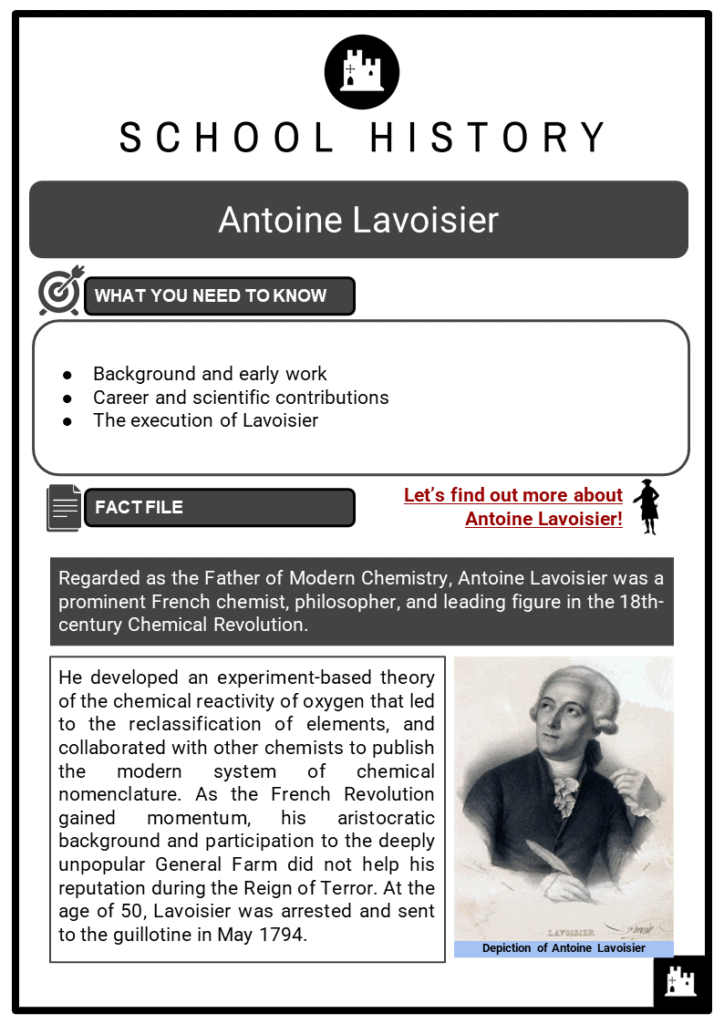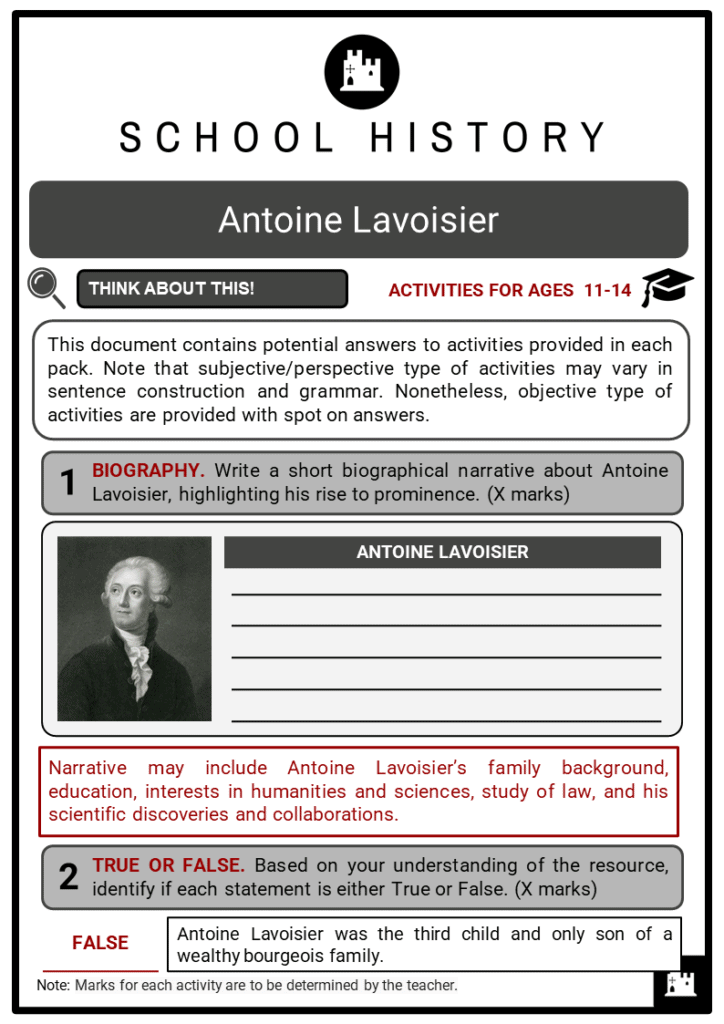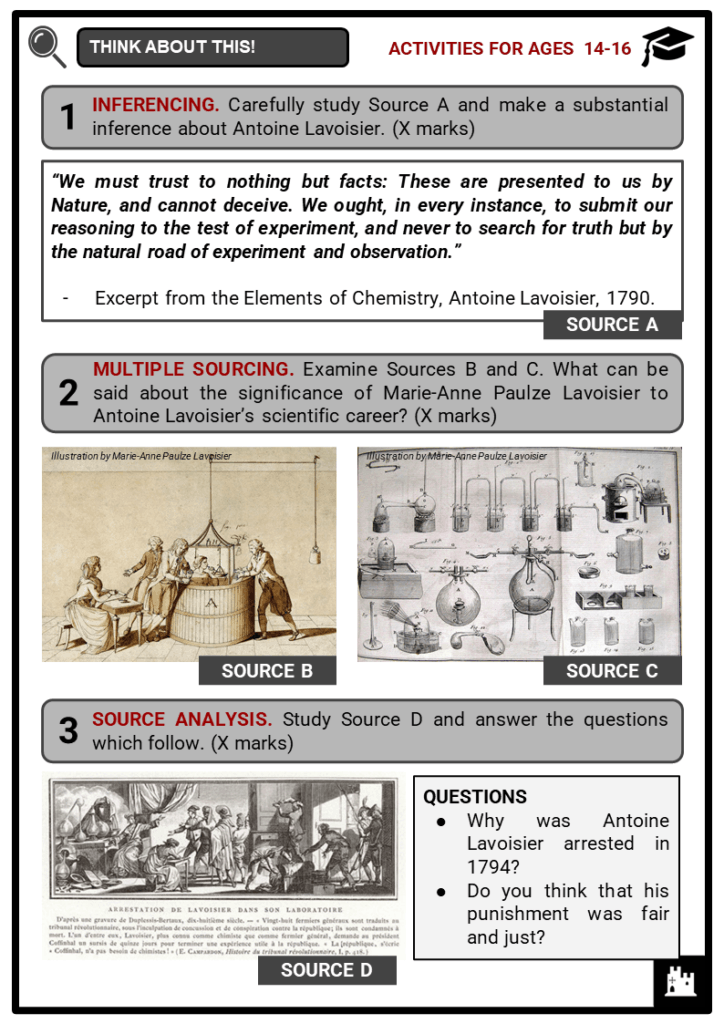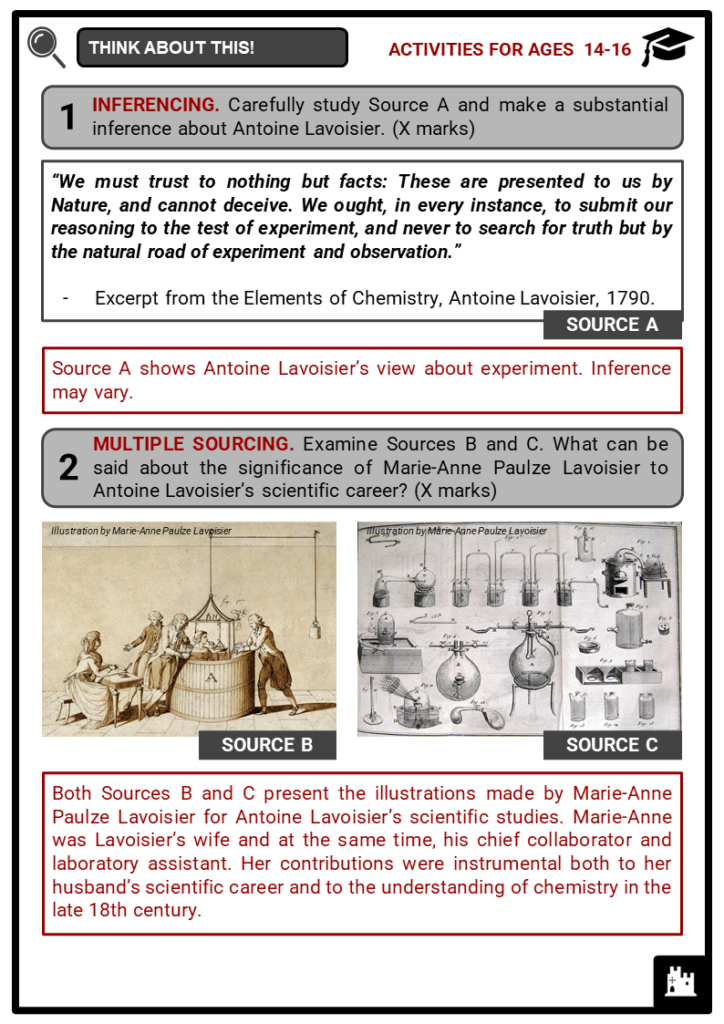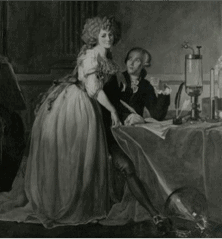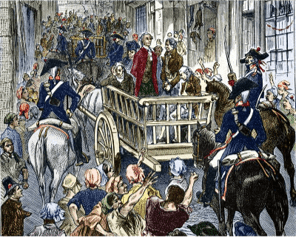Download Antoine Lavoisier Worksheets
Do you want to save dozens of hours in time? Get your evenings and weekends back? Be able to teach Antoine Lavoisier to your students?
Our worksheet bundle includes a fact file and printable worksheets and student activities. Perfect for both the classroom and homeschooling!
Table of Contents
Add a header to begin generating the table of contents
Summary
- Background and early work
- Career and scientific contributions
- The execution of Lavoisier
Key Facts And Information
Let’s find out more about Antoine Lavoisier!
- Regarded as the Father of Modern Chemistry, Antoine Lavoisier was a prominent French chemist, philosopher, and leading figure in the 18th-century Chemical Revolution.
- He developed an experiment-based theory of the chemical reactivity of oxygen that led to the reclassification of elements, and collaborated with other chemists to publish the modern system of chemical nomenclature. As the French Revolution gained momentum, his aristocratic background and participation to the deeply unpopular General Farm did not help his reputation during the Reign of Terror. At the age of 50, Lavoisier was arrested and sent to the guillotine in May 1794.
Background and early work
- Born on 26 August 1743 in Paris, Antoine-Laurent Lavoisier was the first child and only son of a wealthy bourgeois family. Upon the death of his mother when he was five years old, he inherited a large fortune. His affluent background enabled him to receive an excellent education.
- Lavoisier displayed an unusual studiousness and concern for the public good as a youth.
- At the age of 11, he began schooling at the prestigious Collège Mazarin, where he grew interested with chemistry, botany, astronomy, and mathematics.
- He then entered the school of law, where he was able to attend public and private lectures on chemistry and physics and work under the tutelage of leading naturalists.
- He received a bachelor's degree in 1763 and a licentiate the following year.
- After completing his legal studies, he was admitted to the elite Order of Barristers, whose members presented cases before the High Court of Paris.
- However, he never practised as a lawyer and instead, he began pursuing scientific research.
- From 1763 to 1767, he had his first chemical publication, worked on a geological survey of Alsace-Lorraine, presented his paper on the chemical and physical properties of gypsum, and was awarded a gold medal by the King for an essay on the problems of urban street lighting.
- For these scientific studies, he was nominated associate member into France’s foremost natural philosophy society, the Academy of Sciences in Paris, in 1768.
- In 1769, he worked on the first geological map of France.
- As a humanitarian, Lavoisier also dedicated a significant portion of his fortune and work toward improving the livelihood of the population by agriculture, industry, and the sciences.
Career and scientific contributions
- Around the time of his election to the Academy of Sciences, Lavoisier bought an interest in a financial enterprise known as the General Farm. The General Farm was a private corporation that collected taxes for the royal government on a profit-and-loss basis. The income Lavoisier earned from buying stocks in the General Farm funded his scientific work and allowed him to keep a comfortable lifestyle.
- At age 28, Lavoisier consolidated his social and economic position by marrying Marie-Anne Pierrette Paulze, the 14-year-old daughter of a senior member of the General Farm with whom he worked.
- A spirited and intelligent young woman, Marie-Anne would later become an important part in Lavoisier's scientific career, particularly in the translation of scientific works written in English (Richard Kirwan's Essay on Phlogiston and Joseph Priestley's research), the recording of the research conducted in the laboratory, and in the preparation of engravings of apparatus for publication.
- In addition, she hosted parties at which distinguished scientists discussed ideas and problems related to chemistry and campaigned for the acceptance of her husband's new theories.
- In 1770, Lavoisier commenced his studies on the phenomenon of combustion, which is considered his most significant contribution to science.
- Two years later, he reported the results of his first experiments on combustion to the Academy, in which he recorded that sulphur and phosphorous increased in weight upon its reduction to lead.
- These findings and a recent study by Joseph Priestley in 1774, in which he successfully isolated a gas (oxygen) that supported combustion with extreme vigour, made it possible for Lavoisier to propose the oxygen theory.
- He discovered the true nature of respiration when he found that it was a process whereby oxygen is taken up by blood in the lungs.
- He presented that respiration was a process of combustion, with the utilisation of oxygen and the production of carbon dioxide.
- Lavoisier’s work was greatly helped by earlier studies that identified and categorised the gases involved in respiration.
- Joseph Black had isolated carbon dioxide in 1757, Henry Cavendish had isolated hydrogen in 1766, while Daniel Rutherford had isolated nitrogen in 1772.
- Lavoisier’s studies were followed by quantitative measurements on changes in weight attending the combustion of numerous organic compounds, and calculations from that of their percentage composition.
- In collaboration with Louis-Bernard Guyton de Morveau, Claude-Louis Berthollet, and Antoine François de Fourcroy, he published a reformed system of chemical terminology in 1787 and a complete reclassification of the elements in 1789.
- Lavoisier was also responsible for the clear concept of ‘element’ as we understand it today.
- Apart from his scientific research, Lavoisier took on administrative duties in other government agencies.
- In 1775, he was made a commissioner of the Royal Gunpowder and Saltpeter Administration.
- As a result of his efforts, he succeeded in improving both the quantity and quality of French gunpowder, and it became a source of revenue for the government.
- For his appointment to the commission, he took up residence in the Royal Arsenal, where he equipped a fine laboratory that attracted young chemists from all over Europe to learn about the ongoing Chemical Revolution.
- This benefitted his scientific career.
- Lavoisier also conducted extensive experiments on agricultural production, directed the government on financial affairs and banking, assisted on a commission whose efforts to unify weights and measures led to the adoption of the metric system, and used his scientific findings to push for better public health in cities and towns. His drive to help the poor in the cities came at a time of upheaval in France – the French Revolution. For anyone with an aristocratic background, the times became very dangerous.
The execution of Lavoisier
- During the progress of the Chemical Revolution, in which Lavoisier emerged as a victor, another revolution was proceeding in which he was destined to play a tragic role.
- Although Lavoisier had served on several projects that benefitted the public, his state activities and participation to the General Farm did not help his reputation during the Reign of Terror, as taxes and poor government reform were the principal motivators during the French Revolution.
- In August 1792, he was ejected from his laboratory at the Royal Arsenal, and in November of that year, the Convention arrested members of the General Farm, who were tried on 2 May 1794.
- The Republic was being purged of its royalist past.
- According to a widespread legend, the appeal to spare Lavoisier’s life so that he could continue his experiments was cut short by Judge Coffinhal, president of the revolutionary court, who said that “the Republic needs neither scholars nor chemists; the course of justice cannot be delayed.”
- Within a few days, Lavoisier, at the age of 50, along with his father-in-law and other colleagues, was condemned to die. On 8 May, he was sent to the guillotine. A year and a half after his execution, he was completely exonerated by the French government and his belongings were delivered to his widow.
Image sources:

